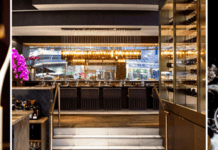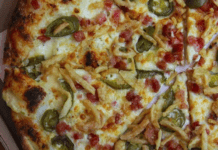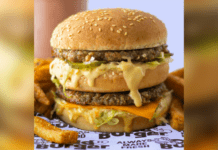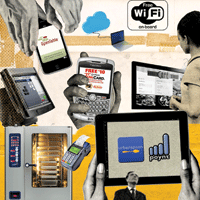Examining 10 technologies trending in foodservice
The world’s advancing at a rapid pace, with technophiles regularly reinventing and creating greater efficiencies. And, although the foodservice industry rarely leads the charge, it isn’t being left behind. “Restaurants have become more competitive and margins have become tighter,” says Kevin Murphy, president of Murphy Group of Restaurants, a company that owns 12 restaurants in P.E.I. “If you’re not using the technology and training what’s out there, you’re going to lose the game. It’s going to be the strongest who survive, yes, but also the smartest and most sophisticated.”
For operators, the trick is finding the tools to evolve with the times. After research and extensive interviews, F&H identified 10 tech trends impacting the foodservice landscape and listed them below in no particular order — so dig in.
Did you know?
Hospitality workers reluctant to stop texting at work bring cheap, portable access points to the job, hook them up to the on-site network and unwittingly (or not) release the restaurant’s secrets online. Enterprise Mobilization.com recently sent a technical architect — and his laptop — into Toronto’s Yorkdale mall to find out how many networks he could access. Of the 103 possible access points, 58 had no security.
1. Wi-Fi Connectivity Goes Mainstream
Considering the influx of impressive technological progress, it’s easy to overlook the fundamental importance of Wi-Fi connectivity. But restaurants that embrace the customer-service opportunity will find the investment pays off with higher orders and in-store lingering. “It encourages a guest to come in between sales calls or meetings, open up a laptop and start working,” says Glen Bowker, president of Enterprise Mobilization, an Aurora, Ont.-based restaurant-technology company. But, it’s not just the mobile road warrior taking advantage of this convenience — it’s the 14- to 32-year-olds whose lives are stored inside their mobile phones. While Wi-Fi’s been prevalent across the foodservice landscape for several years, it’s typically been limited to a franchisee level. Only recently has the practice gained widespread corporate acceptance. McDon-ald’s and Cara are already offering free Wi-Fi and Tim Hortons is in transition, too.
2. Mobile Technology vs. Tablet Revolution
“It’s not clear yet whether the killer apps that’ll change the way people pay or maybe even order at restaurants will be on their mobile devices or on [facility-supplied] tablets,” says Erik Thoresen, director of Research and Consulting at the Chicago-based research firm, Technomic. Regardless, the restaurant customer experience will soon be about electronic exchange. Given that smartphone penetration already hovers at 50 per cent in the U.S., and that tablet-based ordering systems come with steep price tags, Thoresen predicts a smartphone victory. “It’s hard, in this environment, to imagine that a restaurant operator would shell out a couple of grand for this kind of thing. On the mobile side, guests come in with the technology already on them.”
Did you know?
Honing in on the foodservice market, Ness is a new app that recommends dining establishments by learning what users like. The “likeness engine” considers ratings, past history (via checkins at Foursquare), reviews and recommendations from a user’s social network. And, it gets smarter with time.
3. The Kitchen Printer’s Death Knell
The days of punching orders into institutional POS devices set off by a kitchen alarm may soon be over. Now sophisticated computerized systems are being installed at individual kitchen stations and designed so each order can be prepared at the same time.“More than anything in foodservice,” says Stephen Seymour, director of Information Technology at Service Inspired Restaurants (SIR Corp.), “these systems are going to have the most significant impact.” The system calculates the prep time for each part of a meal, considering, for example, that if a guest wants his steak well done, it’s going to take longer. Guests wait less time for their orders, food is consistently hot and meals are ready for a table at the same time. This innovation delivers unprecedented order to the chaotic kitchen. “Go into a restaurant putting out $8,000 an hour of food, and things are moving so fast people are always on the verge of panic,” says Seymour. “Then walk into a kitchen using a display system, and it’s beyond smooth, almost spooky.” Long popular in the QSR scene, kitchen-automation systems are just now mature enough to meaningfully impact table service. Seymour predicts the machines will be common in five years.
4. Order Optimization
The new digital age frees restaurateurs from making quarterly reinvestments in leather-bound paper menus, while offering opportunities to update pricing and enhance the diners’ ordering experience (customers can score a wine-pairing recommendation from the head bartender, for example). “The beauty of tableside ordering,” says Glen Bowker, president of Enterprise Mobilization, an Aurora, Ont.-based resto-tech company, is it demands perfection because the server is facing the customer. “The machine’s in your hand, and it’s saying: ‘You must enter a modifier about how you want that cooked.’” As an added bonus, fast-food operators can use this handheld technology to take orders in a crowd.
Did you know?
Next-generation POS software spares operators the hassle that comes with managing accounting and payroll by integrating these labour-intensive tasks into a single smart technology. One system registers employees’ in-and-outs and communicates to the payroll software, which accounts for benefits and then advises a bank deposit into staff accounts, while automatically printing pay stubs. Kevin Murphy, president of Murphy Group of Restaurants, has software at his 12 P.E.I. restaurants that enables the manager to have everything downloaded — from the hours worked through the sign-in and -out function — which, in turn, calculates hourly labour costs as a percentage and a dollar amount. It also alerts employee payroll software to the weekly hours worked and pays by automatic deposit. This kind of technology is critical for running a successful restaurant, says Murphy, “as labour accounts for 32 per cent to 35 per cent of the sales dollar and needs to be managed hourly.”
5. Couponing in the Digital Age
Tim Hortons, Starbucks, Chipotle and the Dunkin chains are among a growing list of American companies that have introduced digital imagers to their retail environments for e-couponing. Here, restaurants send opt-in QR-code coupons to customers’ phones, offering deals, often associated with the phone user’s proximity to the establishment in question. “They get a 100-per-cent hit rate,” raves Glen Bowker of Enterprise Mobilization, who recently facilitated Baskin Robbins’ email promotion of an SMS coupon for 25 per cent off a second scoop on a Saturday morning when the temperature reached 30˚C. The offer immediately reached 140,000 email addresses, the holders of which were prompted to visit the store and scan their phone at a digital imager. Such innovations are easy and environmentally sound — just think of the paper coupons being saved.
6. Food Finders
The development of location-based food-discovery apps means hungry patrons can hand the vexing task of finding a dinner spot to their smartphones. Using one of a number of new applications, techno-equipped would-be diners press a button that launches GPS functions to match them with, say, 15 sushi restaurants within a kilometre of their location. “The technology is out there already, being deployed and tweaked,” says Erik Thoresen of the Chicago-based Technomic research firm. “We’re going to see a lot more people playing around in that space and a leader will emerge.”
7. Getting PCI Compliant
The imperative of foodservice players to comply with payment-card-firm-imposed sanctions with regard to chip-equipped payment continues to be a major industry issue. It’s why operators are spending fistfuls of cash on PCI-compliance software and rogue-access-point-projection software (to intercept if someone is hacking into a network to steal proprietary information). This added safety measure is critical given that credit-card companies have absolved themselves of any responsibility of operators’ self-imposed exposure to security threats, which are more jeopardized in restaurants than anywhere, says Glen Bowker, president of Aurora, Ont.’s Enterprise Mobilization. Five years ago, Winners disclosed that as many as two-million Canadian credit cards might have been accessed by computer hackers, an oversight that cost the company millions in fines and lost business. The presence of this kind of technology would have avoided such an expensive mistake.
8. Tableside Dining
Already popular in many foodservice environments, tableside iPads portend a complete ordering and payment overhaul. The sleek devices enhance the customer experience, allowing guests to customize their meals, while learning more about what they ordered. And the improvements don’t stop there. The kids can play Angry Birds, and their parents can order movie tickets while they’re waiting for the food. Still, restaurateurs are anxious to maintain a full-service element to their operation, so they’re giving the iPads to the server, rather than leaving them in the hands of the customer. There are 10 new iPads at Daniel Brennen’s Brickhouse, a 150-year-old charmer in Charlottetown, which falls under the Murphy Group of Restaurants’ umbrella. Featuring wine, cocktail and beer lists, these technical wonders offer customers the choice to source wine from a particular region. “It’s cool,” says Kevin Murphy of the Murphy Group. “We’re really the first in Atlantic Canada, and anytime you’re doing something first, you always get that cachet.” Erik Thoresen of Chicago’s Technomic predicts the buy-in from large chains will push tablets into the market (alongside smartphones) in a big way.
Did you know?
New mobile apps and dongles (hardware that attaches to a mobile device for a secure connection) mean retailers can now reliably process plastic payments on their mobile devices outside their physical operation. “It’s changing the rules about who can process credit cards,” says Glen Bowker of Aurora, Ont.’s Enterprise Mobilization, who points out that restaurant operators will increasingly be able to sidestep high credit-card-processing fees as innovation continues.
9. Cloud Computing
In a table-service restaurant with 400 bums in seats, it’s tricky for the proprietor to say, “We can’t take your payment right now.” And the regulated chip-and-PIN obligation means it’s increasingly difficult to rely on backups. But, thanks to cloud-based computing and virtualized computer systems, infrastructure resilience is the new baseline for front-line foodservice. “Building resiliency into your Internet connection is a requirement now,” says Stephen Seymour of SIR Corp., who points out that virtualization reduces disaster recovery from an eight-hour to a 10-to-15-minute window. By converting your POS system into a virtual machine, you’re spared the hassle of going manual in case of failure. “If your store goes down, you’re not screwed,” sums up Glen Bowker of Aurora, Ont.’s Enterprise Mobilization.
10. Red-Hot Smart Ovens
Intelligently designed and meticulously engineered oven/microwave/steamer combos are the next wave in cooking. They do everything swiftly and to order, combining the functions of microwave, convection and steaming appliances. Food cooks fast — up to 15 times quicker than traditional cooking methods — with quality results, the speedy convenience of a microwave and the browning function of a standard oven. These computerized marvels feature programmable cooking programs, ventless installation (saving on costly vent hoods) and intuitive menu functions. Kevin Murphy of the Murphy Group of Restaurants introduced Combi ovens at his dozen Charlottetown restaurants a year ago, and he has never looked back. “You put a piece of salmon in, hit the ‘salmon’ button and, boom, the fish is done perfectly every time — and in such a way that you’d never know it wasn’t put in a convection oven,” he says. “These units aren’t cheap, but the technology, quality and consistency that come out of them beat everything.”
Keep Reading
Will Social Media Help Build Your Business?
Foodservice Trend Report 2012 (Food, Operations, Technology, Social Media, Greening)
The Tracker: Smart Inventory Technology




















